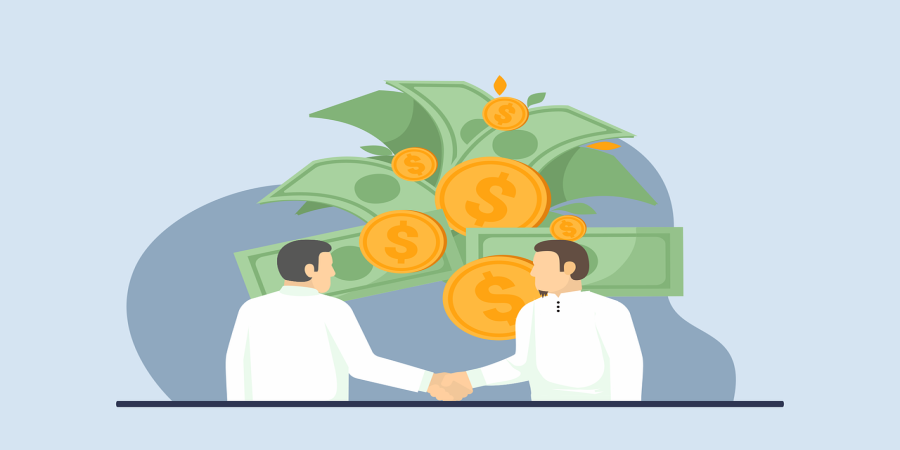

The Power of Compound Interest: How Small Investments Grow Big
Introduction to Compound Interest
- Compound interest represents a fundamental principle in the realm of personal finance and investing, exerting a considerable influence on wealth accumulation. At its core, this financial concept refers to the process where the interest earned on an investment or savings account is reinvested to generate additional earnings over time. This can be exemplified through the common phrase, "interest on interest," which succinctly encapsulates the essence of how compound interest operates.
- The significance of compound interest in personal finance cannot be overstated. It allows individuals to grow their savings and investment portfolios exponentially, rather than linearly, as is the case with simple interest. With compound interest, even small, consistent contributions can lead to substantial growth over the years. This is particularly advantageous for long-term savings goals, such as retirement or education funds, where time works as an ally to enhance the overall investment outcome.
- Understanding the power of compound interest enables investors to make informed decisions regarding their financial strategies. By recognizing the benefits of early and consistent contributions, one can take full advantage of this principle. The earlier an individual begins to invest, the more pronounced the effects of compounding become, fostering a sense of urgency when it comes to personal financial planning. Investing even modest amounts consistently can lead to significant financial growth, unlocking a pathway to financial independence and security. Furthermore, the ability to forecast future wealth through this principle empowers individuals to set measurable goals and track their progress effectively.
- In summary, grasping the concept of compound interest is vital for anyone engaged in personal finance and investing. By harnessing the power of compound interest, even minimal investments can evolve into substantial wealth over time, illustrating the importance of patience and persistence in the financial journey.
The Formula for Compound Interest
Understanding the formula for compound interest is essential for making informed investment decisions. The general mathematical formula can be expressed as:
A = P (1 + r/n)^(nt)
In this formula, each component plays a critical role in calculating the final amount accrued from an investment, showcasing the remarkable power of compound. Here is a breakdown of the variables:
- A represents the total amount of money accumulated after n years, including interest. This is the final value of your investment and demonstrates how small contributions can significantly grow over time.
- P is the principal amount, which refers to the initial amount of money invested or borrowed. It serves as the base figure for calculating the compound interest.
- r stands for the annual interest rate expressed as a decimal. For example, if the interest rate is 5%, it would be represented as 0.05 in the formula. This rate is pivotal, influencing how quickly an investment grows due to the power of compound.
- n denotes the number of times interest is compounded per year. Common compounding frequencies include annually, semi-annually, quarterly, or monthly. The frequency of compounding affects the total interest accrued, with more frequent compounding resulting in a larger amount over time.
- t represents the number of years the money is invested or borrowed for. This duration plays a crucial role in determining how much growth can occur, especially when combined with the interest rate and compounding frequency.
By understanding these variables and how they interrelate, investors can harness the power of compound to make savvy financial decisions, ultimately leading to greater end wealth.
The Time Factor: Why Start Early?
- Investing early is one of the key strategies to harness the power of compound interest. The essence of compound interest lies in its ability to generate earnings on both the initial principal and the accumulated interest from previous periods. This means that the sooner one starts investing, the more pronounced the effects of compounding will be over time. A classic example can illustrate this principle effectively. Consider two individuals: one starts investing $1,000 at age 25 and continues to contribute $100 per month until age 65. The other individual waits until age 35 to make the same investments. Assuming an average annual return of 7%, the first investor will have a significantly larger nest egg by retirement compared to the second, even though the latter invests for a decade longer.
- To quantify this, the first investor would accumulate approximately $1.13 million by the time they reach 65, while the second individual would only amass around $700,000. This stark contrast highlights the incredible impact of time on growth potential. It is not just the amount invested but the duration of that investment that enhances the benefits drawn from the power of compound growth. Hence, starting early allows your money to work for you for a longer period, maximizing returns effectively.
- Moreover, even small contributions can lead to substantial sums over the decades. For instance, by investing just $50 per month starting at age 20, accumulating with compound interest, one could achieve over $85,000 by retirement. In contrast, the same investment starting at age 40 would yield only about $25,000, a difference driven purely by the time factor. Thus, the earlier one begins the journey of investing, the more compelling the argument for utilizing the power of compound interest becomes. It is clear that time plays a pivotal role in investment strategy and long-term financial success.
Real-Life Examples of Compound Interest in Action
- Understanding the concept of compound interest can sometimes feel abstract, yet real-life examples vividly illustrate its potential benefits. One of the most significant case studies involves a young professional, Jane, who began investing at the age of 25. Jane decided to invest $2,000 annually in a diversified index fund that offered an average annual return of 7%. By the time she reached 65, her contributions resulted in a retirement account of over $600,000, showcasing the extraordinary power of compound interest over time. This highlight reinforces that starting early can lead to substantial financial growth.
- Another compelling example features a middle-aged individual, Mark, who began investing later in life at age 45. He committed to a larger annual investment of $10,000, yet due to his later start, he only accumulated about $300,000 by age 65. While this represents a significant financial achievement, it also emphasizes the difference that time makes in harnessing the power of compound interest. The longer one allows their investment to grow, the more pronounced the benefits of compounding will be.
- Further illustrating this principle, a high school student, Sarah, utilized her part-time job earnings to open a Roth IRA, contributing $1,200 each year from age 18 to 24. By the time she is ready to retire, even if she never contributes again, her account could reach a substantial sum due to the long-term effects of compound growth. These varied scenarios demonstrate that individuals from different backgrounds can benefit from the power of compound interest, irrespective of their starting point or investment strategies. Whether starting early, investing larger amounts later, or making modest contributions over time, the principle remains clear: compound interest is a powerful tool that can lead to wealth accumulation.
Strategies for Maximizing Compound Interest
- Maximizing the power of compound interest requires a strategic approach to investing, which includes regular contributions, selecting suitable investment vehicles, and understanding one’s risk tolerance. One of the most effective strategies for optimizing compound interest is to establish a routine of consistent contributions. By making regular deposits into savings or investment accounts, individuals can take full advantage of compounding. Whether through automatic transfers to a retirement account or regular payments into an investment fund, consistency not only cultivates discipline but also accelerates the compounding effect over time.
- Choosing the right investment vehicles is another critical component in leveraging the power of compound interest. Forlong-term growth, individuals should consider options that offer compound interest benefits, such as high-yield savings accounts, certificates of deposit (CDs), and diverse portfolios encompassing stocks, bonds, and mutual funds. Each vehicle comes with its own risk and return potential, meaning it is essential for investors to assess their risk tolerance carefully. Understanding how much risk one can comfortably assume will aid in selecting investments that are likely to provide a balance between safety and growth, ultimately facilitating the advantages of compound interest.
- As market conditions fluctuate, it is also vital to periodically review and rebalance one’s investment portfolio. This assessment might involve shifting investments to take advantage of higher yield opportunities or adjusting based on changing personal financial goals. Additionally, remaining committed to the long-term vision of compound interest will help investors avoid the pitfalls of panic selling during market downturns. By maintaining a disciplined approach and staying informed about investment options, individuals can effectively harness the power of compound interest, leading to substantial financial growth over time.
Common Mistakes to Avoid with Compound Interest
- When utilizing the power of compound interest, investors often make several crucial mistakes that can hinder their potential for growth. Recognizing these common pitfalls is essential for maximizing investment outcomes and reaping the benefits of compounding.
- One prevalent mistake involves withdrawing funds too early from an investment account. Many individuals may feel tempted to access their returns before reaching their investment goals. However, every withdrawal diminishes the amount of principal available to accrue interest. The longer the investment remains untouched, the greater the compounding effect can be. Early withdrawals can significantly undermine the potential growth of one's investment portfolio, leading to diminished returns over time.
- Another significant error investors often make is failing to reinvest the returns generated by their investments. When earnings are withdrawn instead of reinvested, the investor misses out on the opportunity to earn compound interest on these returns. Reinvesting dividends or interest payments into the original investment can enhance the overall growth trajectory. By neglecting to reinvest, individuals effectively limit the power of compound interest, preventing their investments from reaching their full potential.
- Additionally, falling prey to high-fee investment products can erode the effects of compounding. Many investors overlook the impact that fees can have on their overall returns. High management fees or transaction costs can substantially diminish the profits generated by an investment over time. It is crucial for investors to carefully assess the fee structure of their chosen investment products and opt for low-cost alternatives whenever possible. By minimizing fees, investors can preserve more of their earnings, allowing their assets to grow more efficiently through the power of compound interest.
- Avoiding these common pitfalls can drastically improve the effectiveness of compound interest and facilitate wealth building over time.
Compound Interest Vs. Simple Interest: What's the Difference?
- Understanding the distinction between compound interest and simple interest is crucial for investors looking to make informed financial decisions. Simple interest is calculated solely on the principal amount, or the initial amount of money invested. The formula for simple interest is straightforward: SI = P × r × t, where SI represents simple interest, P is the principal, r is the rate of interest per period, and t is the time in years. For example, if you invest $1,000 at a simple interest rate of 5% for three years, the interest earned would be $150, resulting in a total of $1,150 at the end of the investment period.
- In contrast, compound interest takes it a step further. It is calculated on the principal amount and also on the accumulated interest from previous periods. This is often referred to as “interest on interest.” The formula for compound interest can be expressed as: CI = P (1 + r/n)^(nt) - P, where CI is compound interest, P is the principal, r is the annual interest rate, n is the number of times interest is compounded per year, and t is the number of years. For example, if the same $1,000 is invested at 5% interest compounded annually over three years, the total would be approximately $1,157.63. This illustrates a growth of $157.63, significantly more than the simple interest scenario.
- The power of compound interest lies in its ability to accelerate growth over time, especially with longer investment horizons. Investors who utilize compound interest can witness their investments flourish due to the exponential nature of compounding, making it a preferred method for long-term financial growth. Understanding these differences is essential for anyone looking to maximize their investment returns.
The Role of Inflation in Compound Interest Optimization
- Inflation plays a crucial role in understanding the true effectiveness of compound interest on investments. As the cost of goods and services rises, the purchasing power of money diminishes, impacting the real returns of any investment. When calculating the potential gains from investments that benefit from the power of compound, it is vital to include inflationary effects to grasp the actual growth of capital over time. For example, if an investment yields a nominal return of 5% annually, but inflation averages 3% during the same period, the real return stands at only 2%.
- It is essential for investors to recognize that while compound interest can result in substantial growth of an initial investment, ignoring inflation can lead to overconfidence in the actual profitability of their financial strategies. To optimize the benefits associated with the power of compound, one must seek investment vehicles that not only offer a favorable interest rate but also have the potential to outpace inflation. Various options exist, such as stocks, real estate, or inflation-protected securities, which adjust returns based on changes in the inflation rate.
- Furthermore, diversification plays a vital role in hedging against inflation. By spreading investments across various asset classes, including those historically resilient to inflation, individuals can enhance the likelihood of their returns outpacing rising costs. Regularly reviewing and adjusting one’s investment portfolio ensures that it aligns with changing economic conditions, enabling investors to harness the complete potential of compound interest while mitigating the adverse effects of inflation. This adaptive approach not only safeguards capital but also fosters a steady growth trajectory conducive to long-term financial success.
Conclusion: Start Compounding Your Wealth Today
- In this discussion, we have explored the remarkable benefits of harnessing the power of compound interest in investment strategies. By acknowledging how even modest contributions can proliferate over time, individuals can develop a clearer understanding of the long-term potential associated with their financial decisions. Small, consistent investments can lead to substantial wealth accumulation when backed by the principles of compounding.
- One of the key points made is the essence of starting early. The sooner one begins to invest, the more time their money has to grow exponentially thanks to compound interest. This principle underscores the urgency of making informed choices about investments, regardless of their scale. By taking action today, you lay the groundwork for future financial stability.
- Moreover, it is essential for investors to remain knowledgeable about various investment vehicles available to maximize the advantages that compounding offers. From high-yield savings accounts to diversified portfolios, being aware of your options and their potential returns can significantly enhance growth over time. Staying engaged with the market and seeking guidance can empower you to make sound financial decisions that leverage the true power of compound interest.
- Ultimately, the journey of compounding wealth starts with a single step. Whether it involves setting aside a small sum monthly or exploring diverse investment opportunities, the important thing is to begin. By committing to a consistent investment strategy and patiently allowing your wealth to grow, you can realize the profound advantages of compounding. Embrace this approach today, and witness how your financial landscape transforms over time.
Popular articles

Dec 10, 2024 09:59 AM

Dec 01, 2024 09:33 AM

Dec 08, 2024 09:56 AM

Nov 30, 2024 09:17 AM

Dec 09, 2024 09:58 AM
Comments (0)